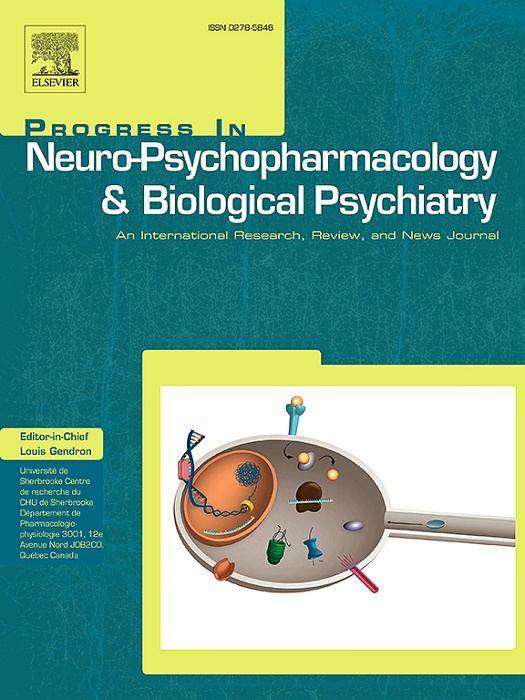心脏代谢指数与重度抑郁障碍:中风和糖尿病作为媒介
IF 5.3
2区 医学
Q1 CLINICAL NEUROLOGY
Progress in Neuro-Psychopharmacology & Biological Psychiatry
Pub Date : 2025-03-25
DOI:10.1016/j.pnpbp.2025.111340
引用次数: 0
摘要
重度抑郁障碍(MDD)是一种严重的情感障碍,显然与中风和糖尿病有关。本研究旨在探讨卒中和糖尿病在心血管代谢指数(CMI)与MDD之间的关联中的中介作用。方法本横断面研究分析了国家健康与营养检查调查(NHANES, 2005-2018)中8312名参与者的数据。使用患者健康问卷-9 (PHQ-9评分)诊断重度抑郁症;10)。使用多元逻辑/线性回归、分层相互作用分析、非线性的限制三次样条(RCS)模型和自举中介检验来评估相关性。结果MDD发生率[OR = 1.36 (95% CI: 1.21-1.51)]与PHQ-9评分[β = 0.55 (95% CI: 0.37-0.73)]呈显著正相关,CMI每增加1个单位。CMIQ4组的卒中风险比CMIQ1组高64% [OR = 1.64 (95% CI: 1.17-2.29)]。森林图显示,在中风、糖尿病、种族、性别和年龄分组下,结果保持稳定。卒中和糖尿病均表现出部分中介作用,间接效应分别占总效应的4.03%和5.37%。通过RCS分析,CMI与MDD、CMI与糖尿病之间存在非线性相关。卒中与MDD之间存在线性关系,维持CMI水平低于0.518可能会降低MDD的风险。结论卒中和糖尿病在CMI和MDD之间起部分介导作用。然而,需要更多的前瞻性研究来仔细检查CMI对MDD的影响。本文章由计算机程序翻译,如有差异,请以英文原文为准。
Cardiometabolic index and major depressive disorder: Stroke and diabetes as mediators
Background
Major depressive disorder (MDD) is a severe affective disorder that is clearly linked to stroke and diabetes. This study aimed to investigate the mediating role of stroke and diabetes in the association between the cardiometabolic index (CMI) and MDD.
Methods
This cross-sectional study analyzed data from 8312 participants in the National Health and Nutrition Examination Survey (NHANES, 2005–2018). MDD was diagnosed using the Patient Health Questionnaire-9 (PHQ-9 score > 10). Associations were evaluated using multivariate logistic/linear regression, stratified interaction analyses, restricted cubic spline (RCS) models for nonlinearity, and bootstrap mediation testing.
Results
There was a robust positive correlation between the incidence of MDD [OR = 1.36 (95 % CI: 1.21–1.51)] and the PHQ-9 score [β = 0.55 (95 % CI: 0.37–0.73)], with a one-unit increase in CMI. The participants in CMIQ4 had a 64 % greater risk of stroke than did the participants in CMIQ1 [OR = 1.64 (95 % CI: 1.17–2.29)]. The forest plot shows that the results remained stable under the grouping of stroke, diabetes, race, gender, and age. Moreover, stroke and diabetes both exhibited partial mediating roles, with indirect effects accounting for 4.03 % and 5.37 % of the total effect, respectively. Through RCS analysis, a nonlinear correlation was observed between CMI and MDD and between CMI and diabetes. There is a linear relationship between stroke and MDD, and maintaining CMI levels below 0.518 may mitigate the risk of MDD.
Conclusion
Stroke and diabetes partially mediated the associations between CMI and MDD. However, additional prospective studies are warranted to scrutinize the impact of CMI on MDD.
求助全文
通过发布文献求助,成功后即可免费获取论文全文。
去求助
来源期刊
CiteScore
12.00
自引率
1.80%
发文量
153
审稿时长
56 days
期刊介绍:
Progress in Neuro-Psychopharmacology & Biological Psychiatry is an international and multidisciplinary journal which aims to ensure the rapid publication of authoritative reviews and research papers dealing with experimental and clinical aspects of neuro-psychopharmacology and biological psychiatry. Issues of the journal are regularly devoted wholly in or in part to a topical subject.
Progress in Neuro-Psychopharmacology & Biological Psychiatry does not publish work on the actions of biological extracts unless the pharmacological active molecular substrate and/or specific receptor binding properties of the extract compounds are elucidated.

 求助内容:
求助内容: 应助结果提醒方式:
应助结果提醒方式:


